2016 MERCEDES-BENZ E-CLASS SALOON airbag
[x] Cancel search: airbagPage 54 of 557
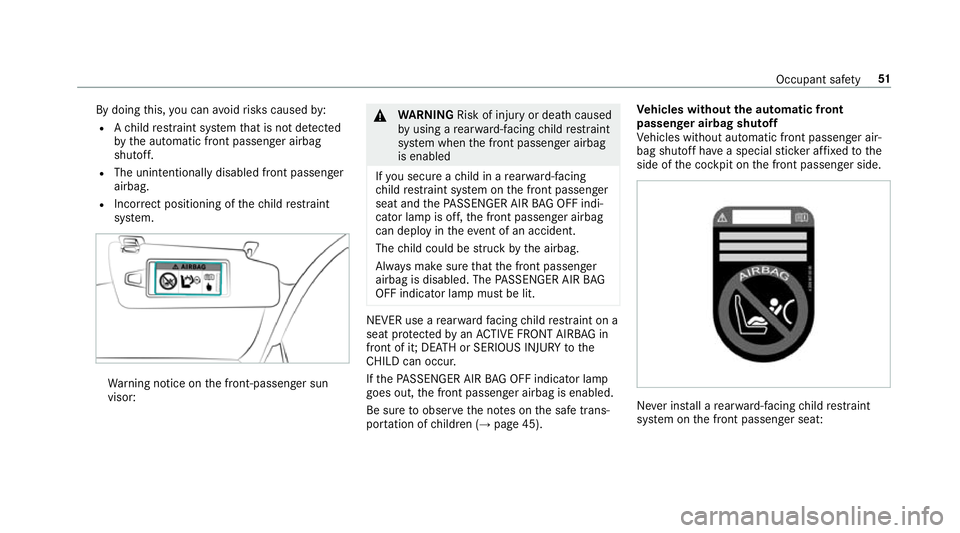
By doing
this, you can avoidrisks caused by:
R Ach ild restra int sy stem that is not de tected
by the automatic front passenger airbag
shutoff.
R The unintentionally disabled front passenger
airbag.
R Incor rect positioning of thech ild restra int
sy stem. Wa
rning notice on the front-passen ger sun
visor: &
WARNING Risk of inju ryor death caused
by using a rear wa rd-facing child restra int
sy stem when the front passenger airbag
is enabled
If yo u secure a child in a rear wa rd-facing
ch ild restra int sy stem on the front passenger
seat and thePA SSENGER AIR BAG OFF indi‐
cator lamp is off, the front passenger airbag
can deploy in theev ent of an accident.
The child could be stru ck bythe airbag.
Alw ays make sure that the front passenger
airbag is disabled. The PASSENGER AIR BAG
OFF indicator lamp must be lit. NEVER use a
rear wa rdfacing child restra int on a
seat pr otected byan ACTIVE FRONT AIRB AGin
front of it; DE ATH or SERIOUS INJU RYtothe
CH ILD can occur.
If th ePA SSENGER AIR BAG OFF indicator lamp
goes out, the front passenger airbag is enabled.
Be sure toobser vethe no tes on the safe trans‐
por tation of children (→ page 45). Ve
hicles without the automatic front
passenger airbag shu toff
Ve hicles without automatic front passenger air‐
bag shutoff ha vea special sticke r af fixe dto the
side of the cockpit on the front passenger side. Ne
ver ins tall a rear wa rd-facing child restra int
sy stem on the front passenger seat: Occupant saf
ety51
Page 55 of 557
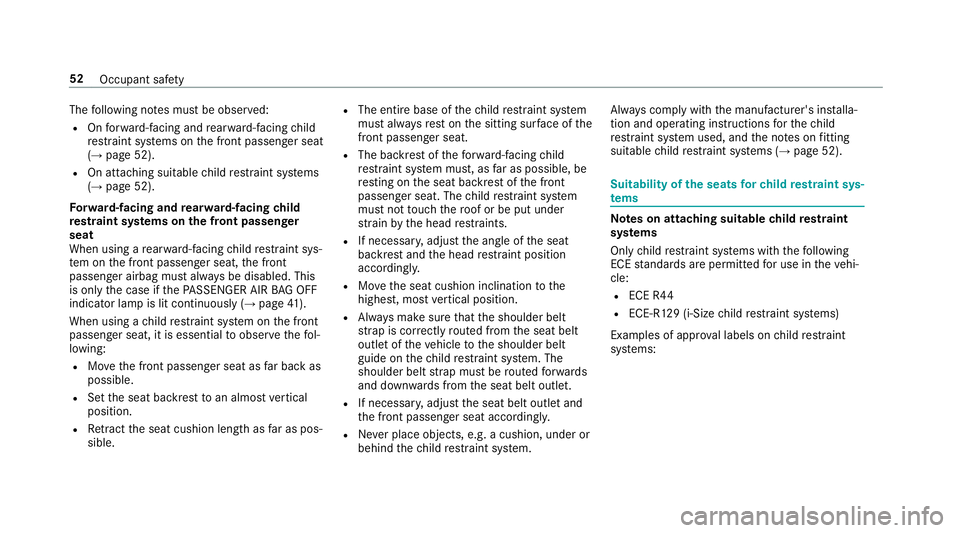
The
following no tes must be obser ved:
R Onforw ard-facing and rear wa rd-facing child
re stra int sy stems on the front passenger seat
(→ page 52).
R On attaching suitable child restra int sy stems
(→ page 52).
Fo rw ard-facing and rear wa rd-facing child
re stra int sy stems on the front passenger
seat
When using a rear wa rd-facing child restra int sys‐
te m on the front passenger seat, the front
passenger airbag must alw ays be disabled. This
is only the case if thePA SSENGER AIR BAG OFF
indicator lamp is lit continuously (→ page41).
When using a child restra int sy stem on the front
passenger seat, it is essential toobser vethefo l‐
lowing:
R Movethe front passenger seat as far back as
possible.
R Set the seat backrest toan almost vertical
position.
R Retract the seat cushion length as far as pos‐
sible. R
The entire base of thech ild restra int sy stem
must alw aysre st on the sitting sur face of the
front passenger seat.
R The backrest of thefo rw ard-facing child
re stra int sy stem must, as far as possible, be
re sting on the seat backrest of the front
passenger seat. The child restra int sy stem
must not touch thero of or be put under
st ra in by the head restra ints.
R If necessar y,adjust the angle of the seat
backrest and the head restra int position
according ly.
R Movethe seat cushion inclination tothe
highest, most vertical position.
R Alw ays make sure that the shoulder belt
st ra p is cor rectly routed from the seat belt
outlet of theve hicle tothe shoulder belt
guide on thech ild restra int sy stem. The
shoulder belt stra p must be routed forw ards
and down wards from the seat belt outlet.
R If necessar y,adjust the seat belt outlet and
th e front passenger seat accordingly.
R Never place objects, e.g. a cushion, under or
behind thech ild restra int sy stem. Alw
ays comply with the manufacturer's ins talla‐
tion and operating instructions forth ech ild
re stra int sy stem used, and the no tes on fitting
suitable child restra int sy stems (→ page 52). Suitability of
the seats forch ild restra int sys‐
te ms Note
s on attaching suitable child restra int
sy stems
On lych ild restra int sy stems with thefo llowing
ECE standards are permit tedfo r use in theve hi‐
cle:
R ECE R44
R ECE-R129 (i-Size child restra int sy stems)
Examples of appr oval labels on child restra int
sy stems: 52
Occupant saf ety
Page 57 of 557
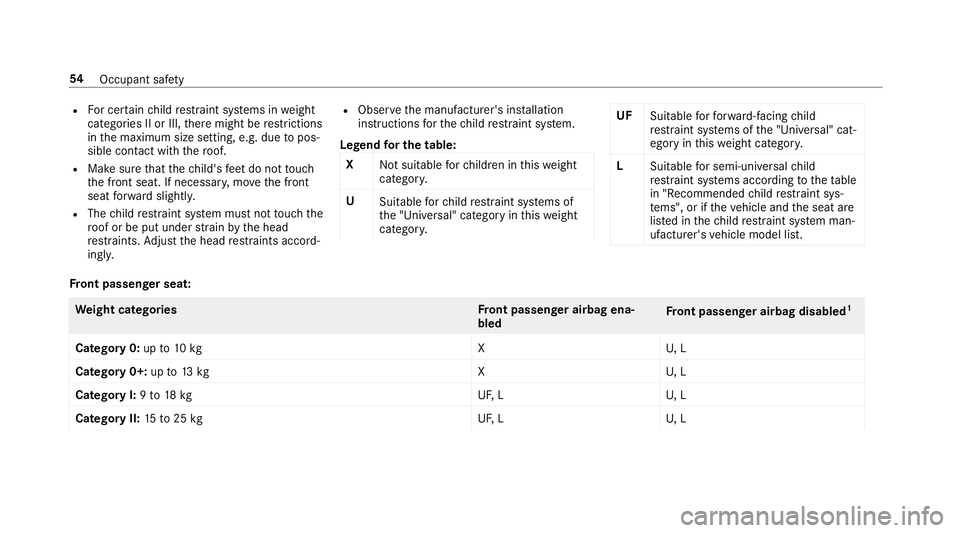
R
For cer tain child restra int sy stems in weight
categories II or III, there might be restrictions
in the maximum size setting, e.g. due topos‐
sible con tact wi th thero of.
R Make sure that thech ild's feet do not touch
th e front seat. If necessar y,mo vethe front
seat forw ard slightl y.
R The child restra int sy stem must not touch the
ro of or be put under stra in by the head
re stra ints. Adjust the head restra ints accord‐
ing ly. R
Obser vethe manufacturer's ins tallation
instructions forth ech ild restra int sy stem.
Legend for the table:
X Not suitable forch ildren in this we ight
categor y.
U Suitable forch ild restra int sy stems of
th e "Universal" category in this we ight
categor y. UF
Suitable forfo rw ard-facing child
re stra int sy stems of the "Universal" cat‐
egory in this we ight categor y.
L Suitable for semi-universal child
re stra int sy stems according totheta ble
in "Recommended child restra int sys‐
te ms", or if theve hicle and the seat are
lis ted in thech ild restra int sy stem man‐
ufacturer's vehicle model list. Fr
ont passenger seat: We
ight categories Front passenger airbag ena‐
bled Fr
ont passenger airbag disabled 1
Category 0: upto10 kg XU, L
Category 0+: upto13 kg XU, L
Category I: 9to 18 kg UF,LU , L
Category II: 15to25 kg UF,LU , L54
Occupant saf ety
Page 58 of 557
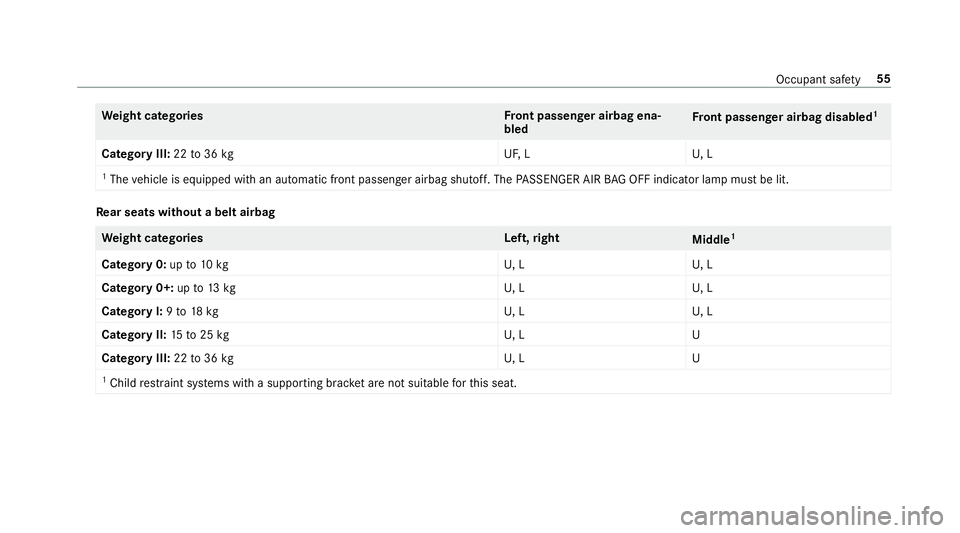
We
ight categories Front passenger airbag ena‐
bled Fr
ont passenger airbag disabled 1
Category III: 22to36 kg UF,LU , L
1 The vehicle is equipped with an automatic front passenger airbag shutoff. The PASSENGER AIR BAG OFF indicator lamp must be lit. Re
ar seats with out a belt airbag We
ight categories Left,right
Middle1
Category 0: upto10 kg U,LU , L
Category 0+: upto13 kg U,LU , L
Category I: 9to 18 kg U,LU , L
Category II: 15to25 kg U,LU
Category III: 22to36 kg U,LU
1 Child restra int sy stems with a supporting brac ket are not suitable forth is seat. Occupant saf
ety55
Page 59 of 557
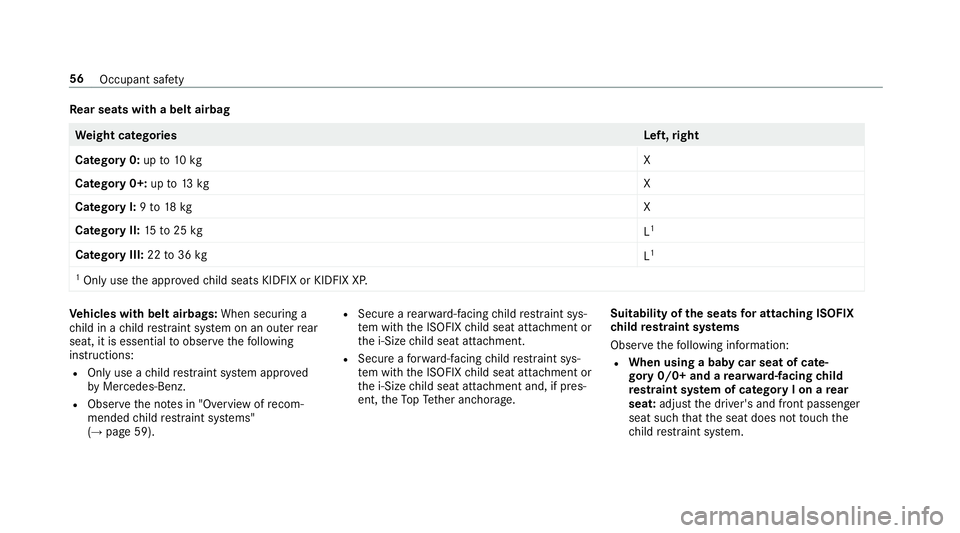
Re
ar seats with a belt airbagWe
ight categories Left,right
Category 0: upto10 kg X
Category 0+: upto13 kg X
Category I: 9to 18 kg X
Category II: 15to25 kg
L1
Category III: 22to36 kg
L1
1 Only use the appr ovedch ild seats KIDFIX or KIDFIX XP. Ve
hicles with belt airbags: When securing a
ch ild in a child restra int sy stem on an outer rear
seat, it is essential toobser vethefo llowing
instructions:
R Only use a child restra int sy stem appr oved
by Mercedes-Benz.
R Obser vethe no tes in "Overview of recom‐
mended child restra int sy stems"
(→ page 59). R
Secure a rear wa rd-facing child restra int sys‐
te m with the ISOFIX child seat attachment or
th e i-Size child seat attachment.
R Secure a forw ard-facing child restra int sys‐
te m with the ISOFIX child seat attachment or
th e i-Size child seat attachment and, if pres‐
ent, theTo pTe ther anchorage. Suitability of
the seats for attaching ISOFIX
ch ild restra int sy stems
Obser vethefo llowing information:
R When using a baby car seat of cate‐
gory 0/0+ and a rear wa rd-facing child
re stra int sy stem of category I on a rear
seat: adjust th e driver's and front passenger
seat such that the seat does not touch the
ch ild restra int sy stem. 56
Occupant saf ety
Page 62 of 557
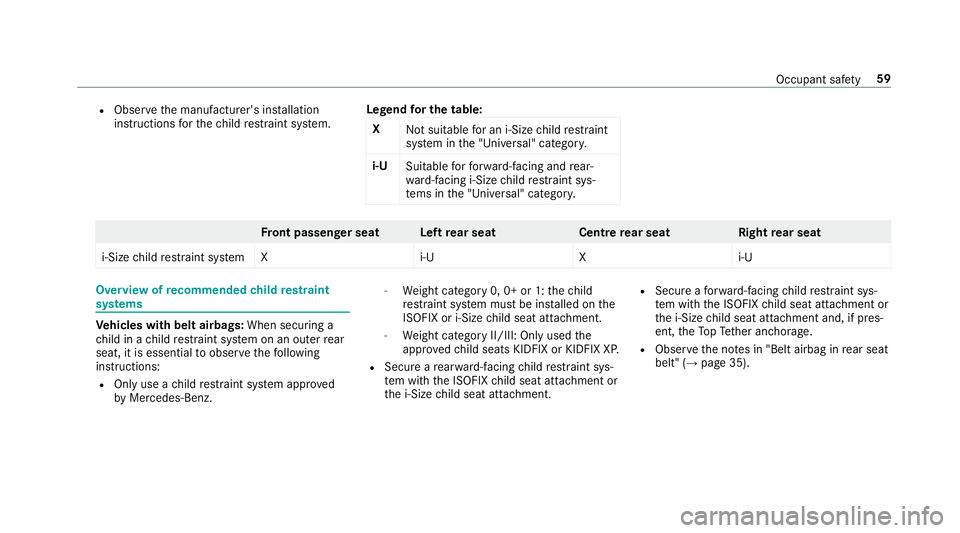
R
Obser vethe manufacturer's ins tallation
instructions forth ech ild restra int sy stem. Legend
for the table:
X Not suitable for an i-Size child restra int
sy stem in the "Universal" categor y.
i‑U Suitable forfo rw ard-facing and rear‐
wa rd-facing i-Size child restra int sys‐
te ms in the "Universal" categor y. Fr
ont passenger seat Left rear seat Centrerear seat Rightrear seat
i‑Size child restra int sy stem Xi ‑UXi ‑UOverview of
recommended child restra int
sy stems Ve
hicles with belt airbags: When securing a
ch ild in a child restra int sy stem on an outer rear
seat, it is essential toobser vethefo llowing
instructions:
R Only use a child restra int sy stem appr oved
by Mercedes-Benz. -
Weight category 0, 0+ or 1: thech ild
re stra int sy stem must be ins talled on the
ISOFIX or i-Size child seat attachment.
- Weight category II/III: Only used the
appr ovedch ild seats KIDFIX or KIDFIX XP.
R Secure a rear wa rd-facing child restra int sys‐
te m with the ISOFIX child seat attachment or
th e i-Size child seat attachment. R
Secure a forw ard-facing child restra int sys‐
te m with the ISOFIX child seat attachment or
th e i-Size child seat attachment and, if pres‐
ent, theTo pTe ther anchorage.
R Obser vethe no tes in "Belt airbag in rear seat
belt" (→ page 35). Occupant saf
ety59
Page 93 of 557

Cor
rect driver's seat position &
WARNING Risk of inju rythro ugh adjust‐
ing vehicle settings while theve hicle is in
motion
Yo u could lose cont rol of theve hicle in the
fo llowing situations:
R ifyo u adjust the driver's seat, the head
re stra ints, thesteering wheel or the mir‐
ro r while theve hicle is in motion
R ifyo ufast enyour seat belt while theve hi‐
cle is in motion #
Before starting the engine: adjust the
driver's seat, the head restra ints, the
st eering wheel or the mir ror and fasten
yo ur seat belt. Obser
vethefo llowing when adjusting steering
wheel 1, seat belt 2and driver's seat 3:
R you are as faraw ay from the driver's airbag
as possible
R you are sitting in a no rmal upright position
R your thighs are slight lysuppor tedby the seat
cushion R
your legs are not entirely stre tched and you
can dep ress the pedals properly
R the back of your head is suppo rted at eye
le ve lby the cent reofthe head restra int
R you can hold thesteering wheel with your
arms slightly bent
R you can mo veyour legs freely
R you can see all the displa ysinthe instrument
clus ter clea rly
R you should ha vea good overview of traf fic
conditions
R the seat belt is pulled snugly against the
body and must be routed across the cent re
of your shoulder and across your hips in the
pelvic area 90
Seats and stowing
Page 94 of 557
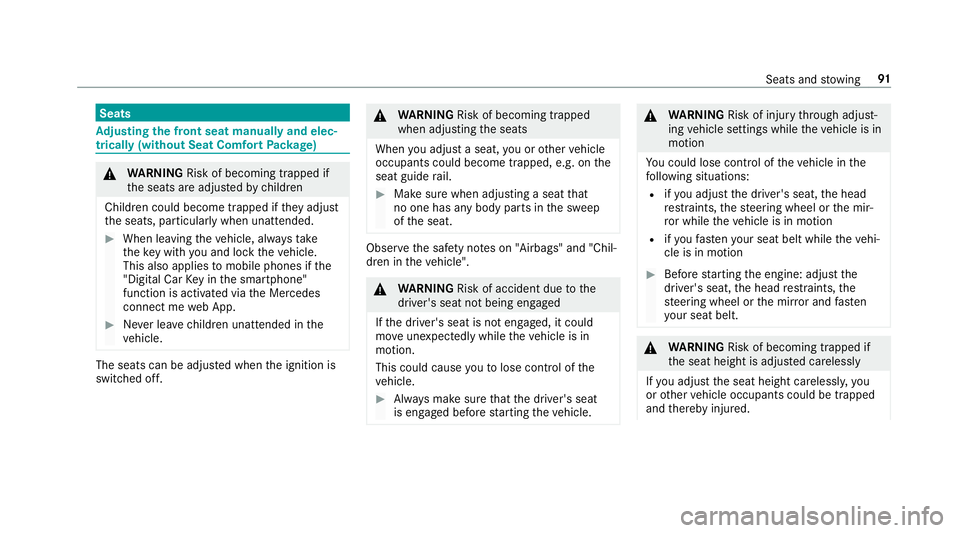
Seats
Ad
justing the front seat manually and elec‐
trically (without Seat Comfort Package) &
WARNING Risk of becoming trapped if
th e seats are adjus tedby children
Children could become trapped if they adjust
th e seats, particularly when unattended. #
When leaving theve hicle, alw aysta ke
th eke y with you and lock theve hicle.
This also applies tomobile phones if the
"Digital Car Key in the smartphone"
function is activated via the Mercedes
connect me web App. #
Never lea vechildren unat tended in the
ve hicle. The seats can be adjus
ted when the ignition is
switched off. &
WARNING Risk of becoming trapped
when adjusting the seats
When you adjust a seat, you or other vehicle
occupants could become trapped, e.g. on the
seat guide rail. #
Make sure when adjusting a seat that
no one has any body parts in the sweep
of the seat. Obser
vethe saf ety no tes on "Airbags" and "Chil‐
dren in theve hicle". &
WARNING Risk of accident due tothe
driver's seat not being engaged
If th e driver's seat is not engaged, it could
mo veunexpectedly while theve hicle is in
motion.
This could cause youto lose control of the
ve hicle. #
Alw ays make sure that the driver's seat
is engaged before starting theve hicle. &
WARNING Risk of inju rythro ugh adjust‐
ing vehicle settings while theve hicle is in
motion
Yo u could lose cont rol of theve hicle in the
fo llowing situations:
R ifyo u adjust the driver's seat, the head
re stra ints, thesteering wheel or the mir‐
ro r while theve hicle is in motion
R ifyo ufast enyour seat belt while theve hi‐
cle is in motion #
Before starting the engine: adjust the
driver's seat, the head restra ints, the
st eering wheel or the mir ror and fasten
yo ur seat belt. &
WARNING Risk of becoming trapped if
th e seat height is adjus ted carelessly
If yo u adjust the seat height carelessly, you
or other vehicle occupants could be trapped
and thereby injured. Seats and
stowing 91